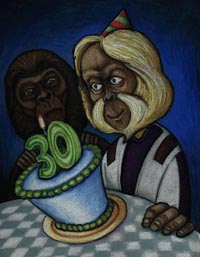 I Left Both Earth and the 20th Century
I Left Both Earth and the 20th Century
The Planet of The Apes Turns 30
by Dave Liljengren
Illustration by Dave Dawson
“I left both Earth and the 20th Century without regret…” intones Charlton Heston as Astronaut Taylor in the original trailer to Francis Schaffner’s 1968 science fiction film, Planet of the Apes.
In this, the 30th anniversary year of POTA‘s release, Heston’s stray promotional patter rings more true than ever. In two years, barring a nuclear flare-up of the kind said to have destroyed the humans in that treasured piece of simian sci-fi, all of us will leave the 20th century behind, likely without regret. And as Heston himself, born in Chicago in 1923, has spent 75 years with the weight of this world on his shoulders, it is probably not long before the Oscar-winning Ben Hur charioteer leaves this “green and insignificant planet” behind.
Meanwhile, back on what remains of terra firma and the 1900s, there is talk of a Hollywood Apes remake. Fan sources on the web say this project has been “green lighted.” A simpler effort in the direction of reawakening POTA interest would involve a simple theatrical re-release with digitized soundtrack, but no such buzz is circulating.
The thirtieth anniversary of POTA means nothing so much as the fact myself and my second-generation TV baby cohorts are now comfortably in mid-life. For a generation of boys, now men in their thirties, POTA was our first free-vee taste of not only big-budget sci-fi, but of adult cynicism and the gripping power of unmistakable, O-Henry-to-the-tenth-power, ironic plot twists.
When we reached the stage of primate development where The Wizard of Oz as a children’s story ceased to fascinate us, we turned on in droves to TV screenings of POTA and its four lesser progeny. The efficacy of POTA parodies on The Simpsons and elsewhere is modern-day proof of this ’70s boyhood phenomena.
Despite more of the heavy-handed gloom that had been so appealing in the first Apes movie – it’s hard to arrive at a more dour plot twist than Taylor’s doomsday bomb detonation at the close of Beneath the Planet of the Apes – the sequels never captivated me as thoroughly as the series opener. When my canon of unmissable reruns grew to include a dark little show from the fifties with an enigmatic narrator, I would understand why.
POTA’s screenplay was co-written by Night Gallery opening, Twilight Zone r, Rod Serling. The “You maniacs! You blew it up! Awww… Damn you… damn you all to hell!” ending to POTA is the grandest closing shocker in a career built on sledgehammer denouements. As the fullest development, the magnum opus, of Serling’s brand of preachy and allegorical, yet still accessible, science fiction, POTA‘s place in the canon of mid- to late-century American environments is as secure as Bill “Major Healey” Daily’s place in the eternal honor guard of comic TV sidekickdom.
Serling’s involvement with the Apes series ended (wisely) after the first movie. Because of this, the other four movies differ so sharply in quality and internal consistency that – while cocktail party Apes scoffers should probably not be allowed to make snide fodder of them – they are of little use in a serious Apes discussion. The qualitative distance between Beneath the POTA and POTA is as clearly defined as the distance between “In the Ghetto” and “Hound Dog.” One rocks and the other doesn’t. “In the Ghetto” and Beneath the POTA can both be entertaining in small doses, but they should not be confused with the genuine articles. Elvis’ legitimacy ended in the army and Apes‘ ended at the Statue of Liberty. All else is epilogue.
But there is enough material in POTA to sustain worthwhile inquiry. A prophet of doom who succeeded best in warning us what not to do, Serling uses men in ape masks to perfect certain of his quirky anti-themes. Religious tyranny, human intolerance, and human shortsightedness all take center stage in POTA.
Serling’s religious whipping boy is POTA‘s enigmatic Dr. Zaius. When first we meet the bad doctor, the “Chief Prosecutor and Defender of the Faith,” as Heston’s Taylor will later call him, he is working like a medieval pope to squelch the Copernicus-like research of Cornelius and Zira, two chimpanzees pursuing the theory that humans evolved from apes. This theory is dangerous to Dr. Zaius because he, an orangutan, is the ecclesiastical numero uno of the ape civilization and the scriptural creation account for his religion, given to the Apes by The Lawgiver, (perhaps a Serling retro-snigger at Heston as Moses in The Ten Commandments) clearly states that apes descended from the mute humans inhabiting their world.
But Zaius is not only a religious leader, he is the chief of scientific inquiry as well. There is a reason for this, we will learn. When Cornelius and Zira present their evidence of intelligent humans, Zaius does not behave in the way we would expect an inquiring scientific mind to do. He attempts to force their silence by threatening their careers. When Taylor breaks the rules of ape court and pleads for his sentient and reproductive life in the reverse Monkey Trial at the center of the film, essentially proving wrong Zaius’s assertion, lifted from sacred writ, that there can be no such thing as an intelligent human, Zaius refuses to listen and shuts down the proceeding.
Zaius then meets privately and talks ape to man with Taylor in the movie’s most moving scene. “I’ve known of your coming for years and I’ve dreaded it,” he says, explaining he’s been privy to evidence of a human civilization for years and has been actively covering up such ideas before they got to the ape populace. The apes need an ordered society and an unchallengeable religion, he says, in order to maintain an ordered society and not destroy themselves.
Later when Taylor escapes with Cornelius and Zira to revisit one of Cornelius’s archaeological digs, Zaius and a contingent of gorilla (literally) soldiers catch up with them. Zaius is forced to examine Cornelius’s irrefutable evidence of an ancient human civilization. Zaius responds by destroying the evidence and arresting Cornelius and Zira. In an out-of-character display of mercy, Zaius allows Taylor and Nova to escape in order for Taylor to find “his destiny.” The destiny to which Zaius refers is the half-buried Lady Liberty and Taylor’s epiphany that mankind both has and will always destroy itself. Thus, as Jesus allows the rich young ruler to go off and experience the spiritual dangers of wealth on his own, Zaius allows Taylor to ride the beach and confront the impulse to self-destruction written into the human genetic code and Zaius’s essential rectitude in deep-sixing ape inquiries into a human past.
While Serling may paint religious types as retrograde deceivers and members of a decidedly non-holy Tri-lateral Commission bent on impeding intellectual growth, it can also be said that Serling was no humanist. He was not shy about sharing testimony of his belief in certain nuclear annihilation. Such sermons loom large in both POTA and The Twilight Zone. Serling is the mad prophet warning of both the dangers of enforced orthodoxy and of unchecked human competition.
I’m guessing that Serling believed the societal acceptance of the theory of evolution and rejection of biblical creation accounts would bring about the end of religion. We’re 30 years past POTA and such late century phenomena as Louis Farrakhan, the Promisekeepers, and the rise of a billion dollar Christian music industry have already proven him wrong. If Serling were alive (he left Earth and the 20th century on June 28, 1975, perhaps without regret) however, such targets as those three would be high on his list of possible subject matter in any cable rebirth of Twilight Zone.
Serling’s take on racism is found in the three-tiered ape society. In POTA ape society, orangutans, with their light colored fur, were at the top, holding most of the positions requiring intellect, while chimpanzees were relegated to glorified house servant status, and gorillas were left in the rain as strapping field hands and mercenaries. When Cornelius ponders the glass-ceiling he has reached at the University because he is a chimpanzee and not an orangutan, Serling wanted the America of 1968 – the year of the Martin Luther King assassination – to look at their own arbitrary distinctions based on skin color. These conflicts are not resolved in the course of the film. Racism, even Serling seems to admit, is something which can’t be unwound in a screenplay.
Serling clearly had a soft spot for the fauna of this world. It’s hard to watch the caging of humans, and their use as test subjects, and not rethink our own failures of compassion regarding the furry, and non-furry, friends with whom we share this planet.
As for leviathan Heston and his acting skills, in POTA and elsewhere, I’m not going to champion them. His unusual range was larger than myth, yet still limited. When he took roles requiring him to precision tune the pomp and thunder theatrics – as in Orson Welles’ Touch of Evil, where Heston tried to portray an emotional Tejano – the results were not for the squeamish.
But I will say Chuck was a bona fide movie star. His pompous demeanor and dulcet tones were popular for a time with directors and moviegoers. Movie actors, even the best ones – even moody Leonardo and beautiful Kate – are props that talk. The director is the artist at work in the cinema. In that context, Heston as a young hunk was a prop who spoke well. When mid-century movie-makers needed a take-charge elocutionist to further their American Dream propaganda, Heston was ready, willing, and naturally gifted with Billy Graham’s patrician good looks.
If we ask how come he didn’t grow artistically and change with the times, we already know the answer. For one, there are few who can do it. Paul Newman is one, but the list is short. More accurately, it boils down to the range thing. Audiences can stomach pompous men when they’re cute. We’ll deal with them through their twenties, thirties, and a year or two into their forties, but after that, if there’s no wisdom of the ages, no likably vulnerable crack in their armor, no self-effacing charm or bright smile, we’ll look elsewhere when investing our $7.50 at the box office.
POTA came late in the game for Heston, (he was 45) and it was his last shining moment. It would take him decades to realize this, but it’s nonetheless true. POTA worked as well as it did because Serling was an old school Hollywood gangsta himself, still interested in fighting the ideological battles of the fifties even as “Tet Offensive,” “bad trip,” and “seriously overcrowded correctional facilities” became household phrases. And if a battle for the soul of the 1950s is being fought, anywhere, at any time, who better to have on your side than Charlton Heston?
There is a proto-hippie ape in POTA, and an inter-species kiss, but Serling’s attempt at contemporaneity is half-hearted. Even as Taylor tells the simian youth at POTA‘s end to “Keep them flying… the flags of discontent,” Taylor rides a horse into the sunset, his obedient, mute, fur-bikinied, woman cuddling close behind him. Taylor is no Aquarian-age hero, he is the last Gary Cooper, the last Western hero whom audiences will follow anywhere, even to the Statue of Liberty and the sobering realization that their destruction is inevitable.



